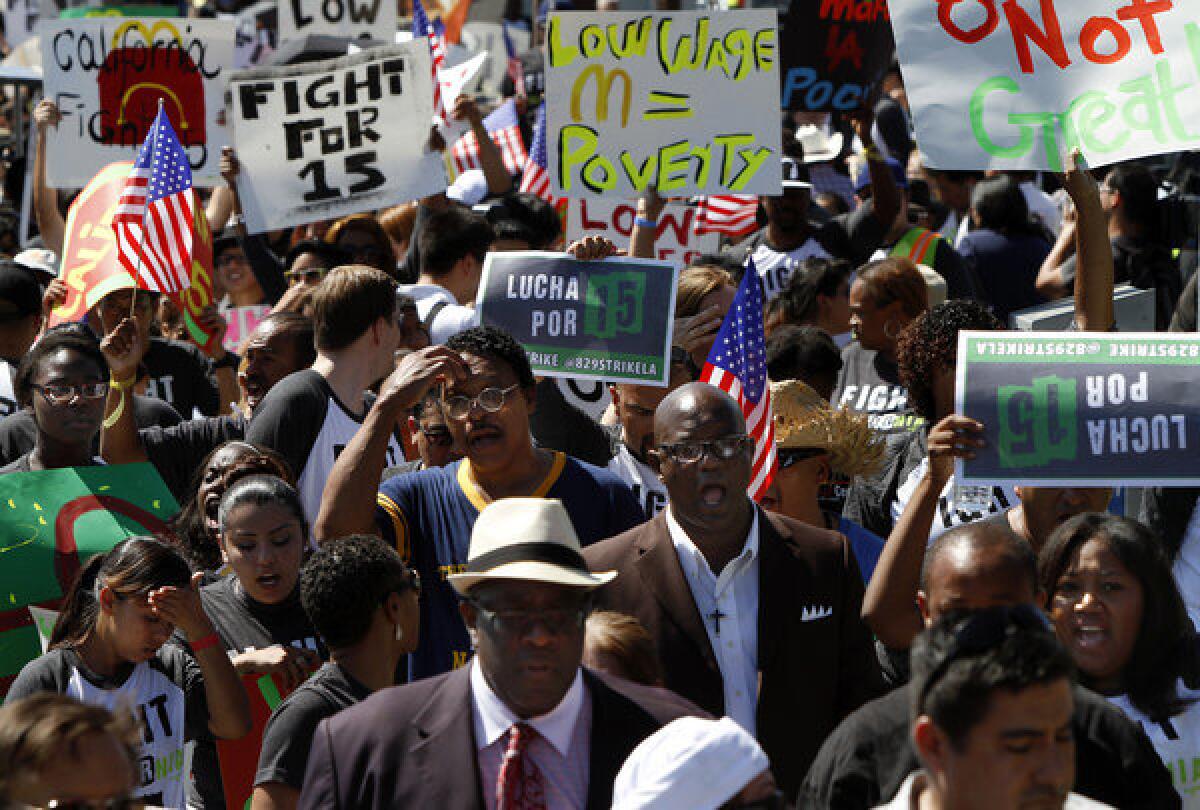Stepping up from flipping burgers

Fast-food restaurant employees across the country walked off their jobs for a day last week, the largest in an escalating series of protests against the low wages paid by some of the nation’s most popular restaurant chains. The workers’ complaints throw a spotlight on the broader challenges policymakers face on this Labor Day, the sixth since the housing market collapse sent the country into an economic tailspin. The problem isn’t just that entry-level jobs have less buying power than they used to; it’s also that too few people are moving on from those jobs into better careers.
The fast-food workers want their pay raised to $15 an hour — more than twice the current federal minimum of $7.25 — but they don’t have the leverage to win such a concession from their employers. If they staged a protracted walkout for higher wages, even if they were unionized, their bosses could easily hire replacements. Under federal law, the strikers could ask for their jobs back in exchange for dropping their demands for raises, but each worker would have to wait for the next available opening. Hence the one-day walkouts, which have led only to small improvements for selected workers.
That’s the reality for many lower-skill workers at a time of stubbornly high underemployment. As of July, 11.5 million Americans were still looking for jobs, and an additional 8.2 million people seeking full-time work were stuck in part-time positions.
PROTEST QUIZ: The numbers behind the friction
It’s worth noting that in towns with vibrant local economies, wages for fast-food workers can be considerably higher than they are in California and other states with long unemployment lines. For example, the oil boom in North Dakota has some McDonald’s restaurants offering $11 or $12 for entry-level help behind the counter and at the drive-through window, sometimes with signing bonuses or guaranteed raises.
The job market sizzled throughout the United States from 1998 to 2000, when strong economic growth pushed unemployment below 4%. Unfortunately, there’s no road map for getting back to that from where we are today, at least not one that squabbling lawmakers can agree on. Meanwhile, businesses are expanding only cautiously in response to tepid growth in consumer spending.
Some economists argue that the government should do what the fast-food workers cannot: force employers to pay a higher minimum wage. Although there would be some jobs lost, they say, the increase would help shift money from company profits to employee paychecks, leading to more consumer spending and faster economic growth — as well as a more livable income for low-skilled workers. Opponents say that the opposite would happen; the increase would deter job creation and slow the already logy economy. Both sides can point to historical studies to support their position, which is why the latest proposals to raise the minimum wage have gone nowhere.
More important than entry-level pay, though, is workers’ ability to advance into higher-income jobs. A report by the Pew Charitable Trusts shows that 43% of those born to families in the bottom fifth of U.S. incomes never rise to a higher rung, and 70% don’t make it to the median income. That lack of mobility belies the American self-image as a land of opportunity. And while Pew’s polls show that the public wants government to promote upward mobility, combating the entrenched, intergenerational poverty in this country presents an enormous challenge.
One place to start is by doing a better job of equipping workers for such a change. Although enormous amounts of tax dollars are spent on various types of career training, the efforts have been inefficient, duplicative and poorly targeted. Federal and state governments are trying, though, to narrow the gap between the skills imparted and the demands of today’s job market.
There’s no obvious way to imbue young people and disadvantaged adults with more marketable skills. Instead, governments are doing a lot of experimentation with career and technical education reforms, including career academies, apprenticeships and partnerships between schools and local employers. The potential payoff is not just a better career path for Americans than flipping burgers and delivering pizzas, it’s a more competitive workforce and a faster-growing economy.
More to Read
A cure for the common opinion
Get thought-provoking perspectives with our weekly newsletter.
You may occasionally receive promotional content from the Los Angeles Times.










